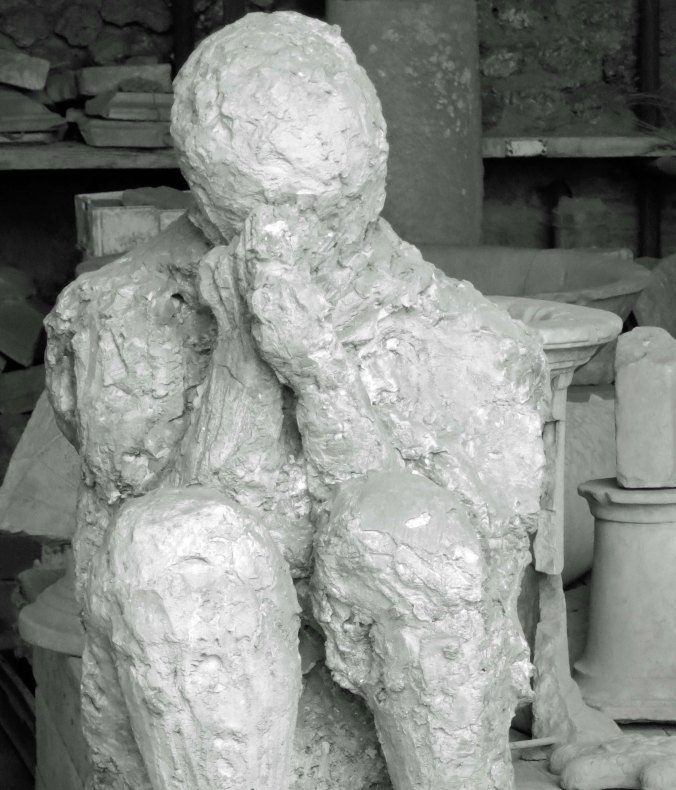
A blanket of ash rushed down from Mt. Vesuvius on Pompeii in 79 CE, suffocating many of the city’s residents. Those who could escape, did. Those who didn’t were covered by a flow of molten rock the next day, preserving their bodies as they died in poses that can still be seen today.
It’s time for another Wednesday photo essay where I scroll through the 75,000+ photos that Peggy and I have taken from around the world and find something that catches my attention. Today it is Ancient Pompeii. Next Wednesday it will be Costa Rica.
Their lives would have been interrupted by a series of small tremors. It had to be worrisome; seventeen years earlier Pompeii had come close to being destroyed in a massive earthquake. The city was still being rebuilt. Possibly the residents woke on the morning of August 24, 79 CE and looked fearfully at the restless mountain that loomed over them— and then went on about their business.

Mt. Vesuvius still looms above Pompeii today. This is what it looks like from the Temple of Jupiter.

Another perspective.
Everything ended at 1:00 PM.
Mt. Vesuvius exploded in a massive eruption sending tons of ash, gas and rocks spewing 20 miles into the sky and forming a dense mushroom cloud. Winds quickly carried the ash into Pompeii, turning day into night and dreams into nightmares. The majority fled, escaping by whatever means available. Those who stayed behind died— suffocating at first under the blanket of thick ash and ultimately, the next morning, by being buried alive under a pyroclastic flow of molten rock and gas that flew down the mountain at speeds close to 100 miles per hour.

It must have been incredibly fast, and frightening.

You have to wonder if this person was simply asleep when it happened.
Viewed from an archeological perspective, history’s tragedy has become today’s blessing. The molten rock and ash that covered Pompeii, also preserved it, providing historians with their most complete view of what life was like in the ancient Roman Empire.

Buildings and streets in Pompeii are well-preserved. Ruts from vehicles using the roads can still be seen, as can road crossings.

Streets were cleaned by flooding them with water. People kept their feet dry by using these crossing stones.
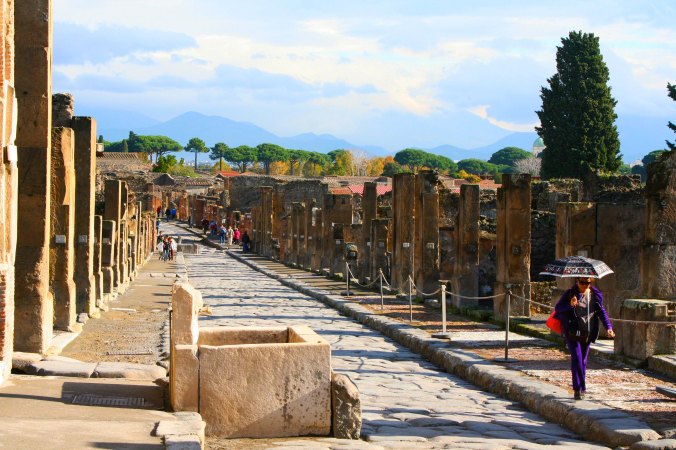
Another street scene. Note how carefully the buildings had been aligned. The square box might have been a community water cistern.

Peggy and I were amused by its modern day equivalent where a faucet was added to the mouth of an early sculpture.

Public baths were a part of most Roman towns and cities. This one was decorated with a detailed relief…
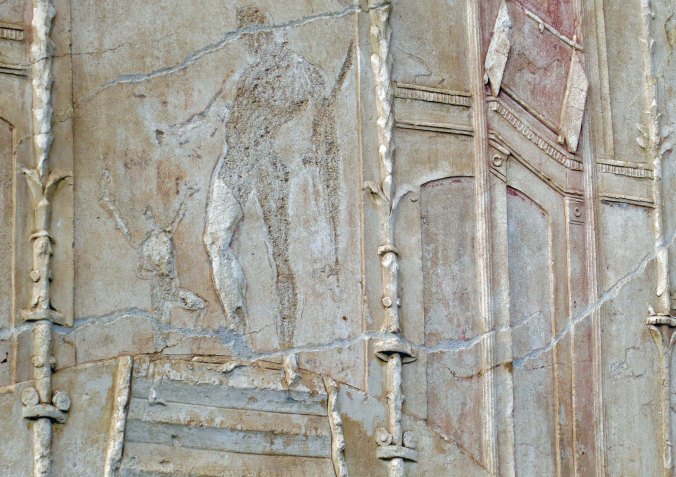
Which included a father and child walking down stairs.
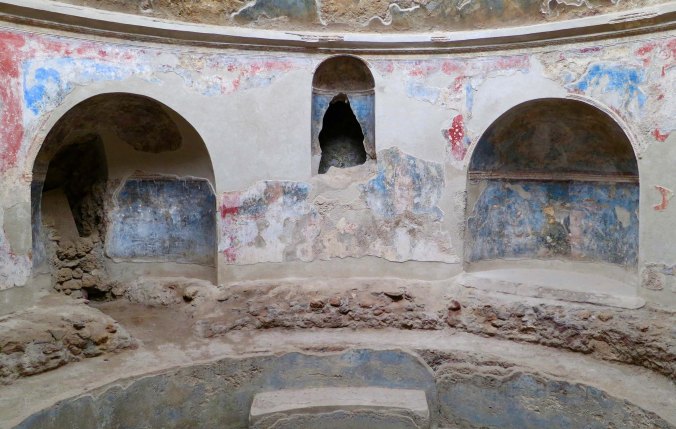
An inside view of the baths provides an idea of how luxurious the baths would have been. Remnants of murals that once covered the walls still remain.
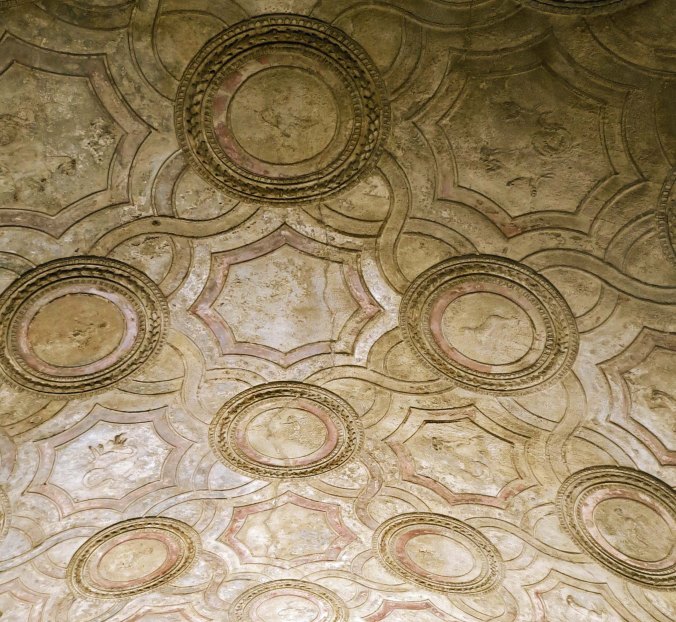
Ceilings were decorated as well. This one shows bas-reliefs of people and animals.
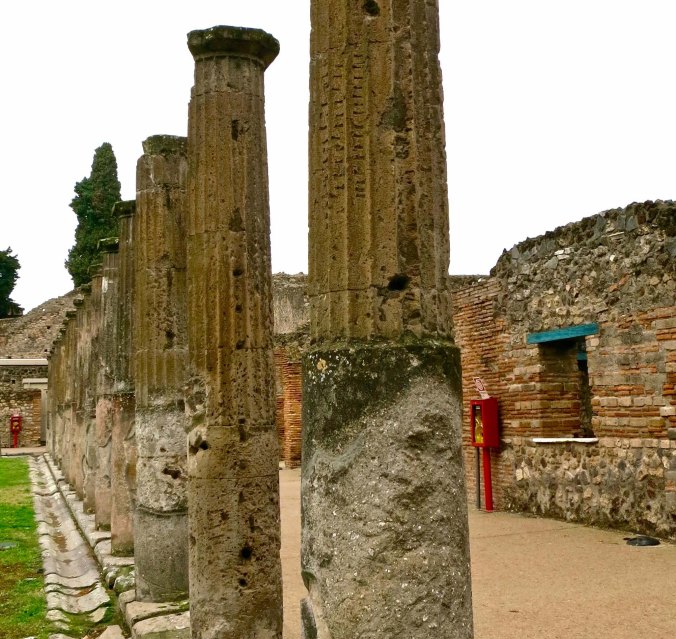
Columns are another thing that most Roman towns shared. These set off a training school of gladiators, who were expected to go out and die for the greater glory of Rome, or to fight and possibly die to entertain Roman citizens. When I closed my eyes, I could almost hear the clashing of swords.

Looking up at one of the columns.
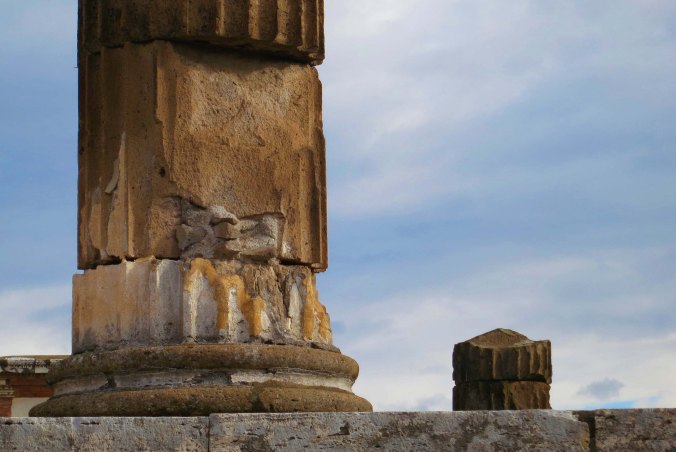
Close-up.

Peggy did a clever job of catching Jupiter with his hand seemingly wrapped around a column in his temple. The god was apparently traveling light that day.
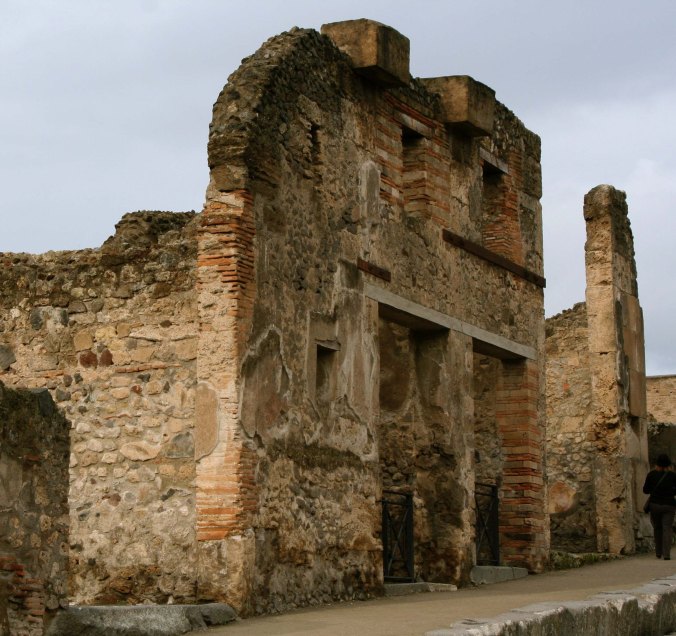
Many of the buildings were remarkably preserved.
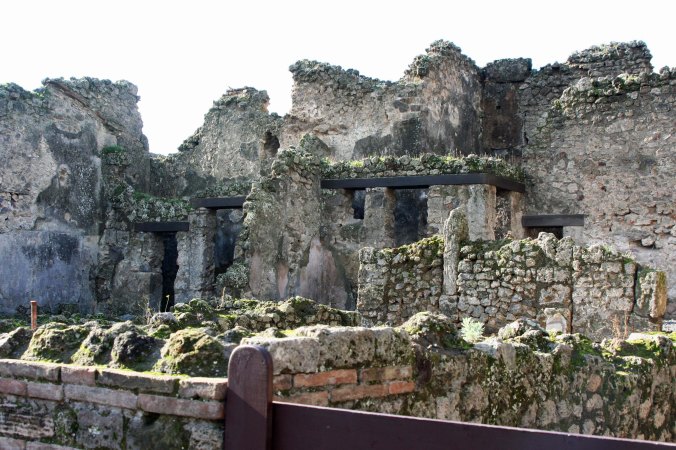
Others more closely resembled other Roman ruins found throughout the Mediterranean.

The Lupanar House of Pleasure or brothel is one of Pompeii’s best preserved buildings and our guide gave us a tour…
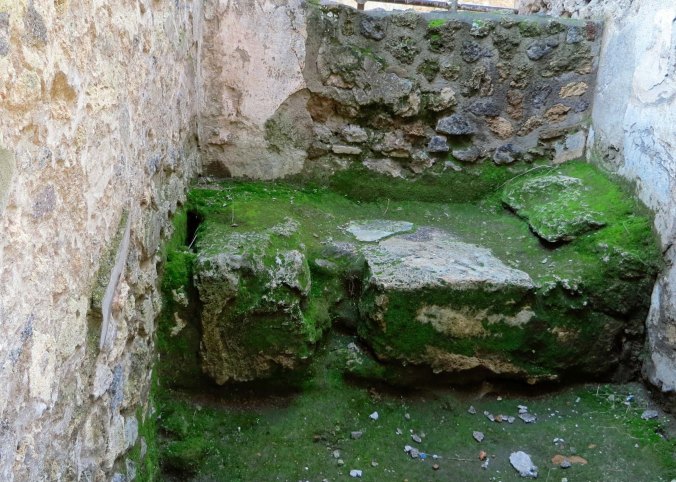
This was one of the beds. It would have been covered with a mattress, but still… The walls of the brothel included paintings that showed the various services available.
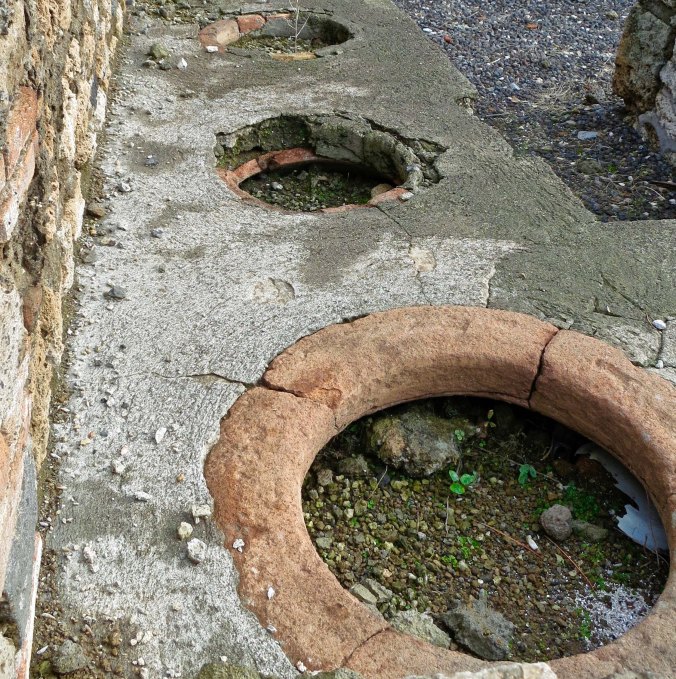
A meal out may have included stopping by this place. These were designed to hold prepared food and keep it hot. It strikes me as a fast food/takeout restaurant.

Bread was baked in this oven.

A large number of storage jars, such as these, were found in the city.

The large amphitheater would have accommodated most of Pompeii’s residents. The rich folks got the lower seats. Those not so fortunate, the upper ‘nosebleed’ seats.
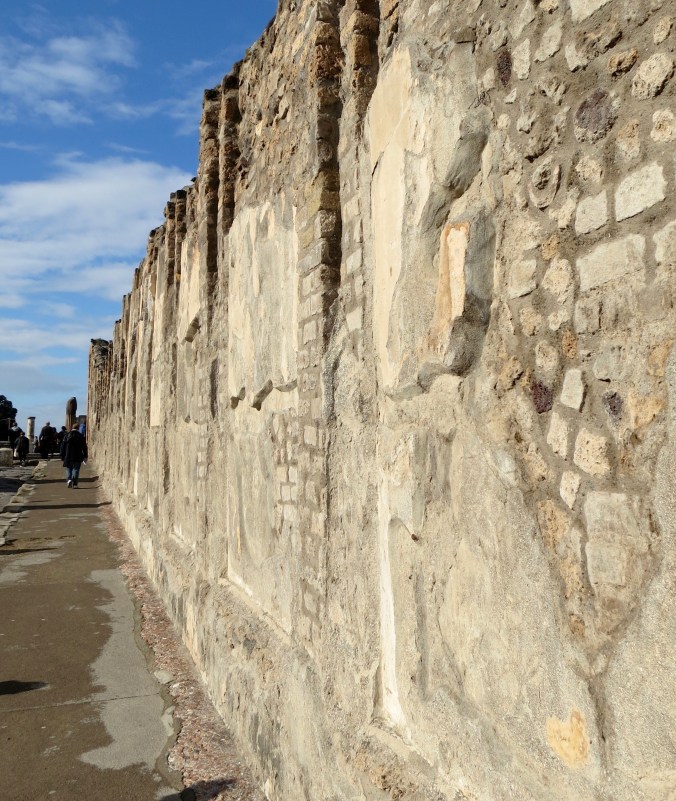
Another street scene in Pompeii. Murals were included on the walls. There must have been a great deal of civic pride in the city.

A little girl and her dog…

And a modern resident of Pompeii.

I’ll conclude with this photo from the Mediterranean side of Pompeii. In 79 CE, the sea was only a couple of hundred yards away. Today it is a couple of miles. Those who had boats or access to boats would have been fleeing from here on that fateful August day, escaping the death that was raining down on their fair city.
FRIDAY’S POST: I determine it’s my job to rule the first grade but no one else seems to agree. Mrs. Young gives me a spanking for my effort.
MONDAY’S POST: It’s all about food on our river trip. And why did Homeland Security determine it was necessary to check our food boxes for a bomb?
WEDNESDAY’S POST: We leave Italy and the Mediterranean to venture off to the Amazon..
The effort you put into your posts is admirable
Thanks. I appreciate your comment. It helps make the effort worthwhile. –Curt
Curt: Absolutely beautiful photos. Pompeii is one of the most incredible places I have ever visited, and I yearn to return, as your photos indicate to me, I have only experienced a small portion of the mysteries. I spoke with a young woman who was actually ‘staying on site’ as she termed it…. doing continuing excavation and preservation work in connection with her education. What an life changing experience.
There is an exhibit in Phoenix right now featuring Pompeii. Not attending. The commercials and advertisements don’t come close to capturing it.
Peggy’s photo of Jupiter is so cool.
Just an excellent gift to your readers are these photos of your visit to Pompeii. Thank you.
Thanks so much, JoHanna. I can only imagine what an experience it would be to participate in the excavation and preservation of a treasure like Pompeii while living on the site! Too bad about Phoenix. I suspect than any exhibition on Pompeii would pale in comparison to an actual visit to the area.
Peggy was pleased with how her photo turned out. 🙂 –Curt
Good post. Thanks for the memory nudge. I went to Pompeii on my first overseas holiday in 1976 and then again in 2004. On the second visit the site was much smaller with only a third of the site that was open to the public in 1976 then being open. Apparently it costs too much to keep it all available all of the time and other parts of it are unsafe to wander around. Actually I preferred nearby Herculaneum which although a lot smaller is much better preserved on account of the fact that it didn’t collapse under the weight of the ash but rather filled up with lave which preserved the infrastructure a whole lot better.
In April Kim and I are going to Naples for a weekend (flight bargain at £55 return, too good to miss) and we will have to make a choice for a day visit between Pompeii and Herculaneum – life can be tough sometimes!
Peggy and I were limited in time, Andrew, so we missed Herculaneum, which was really too bad. Have you been to the National Archeological Museum in Naples that features treasures from the two locations as well as others. If you haven’t it is well worth the visit. –Curt
I went there in 1976 so am due a return visit. I recall that the exhibits were not especially well cared for, one visitor was told off because he sat down on a 2,000 year old bed that looked quite fragile. I imagine that they have tightened that up!
We found it in good condition, Andrew. I might do a photo essay on it. Did they have the “Secret Room” that features what would be “R rated” in today’s were but folks were open about then, when you displayed a flying phallus for good luck? It’s interesting… –Curt
I remember a room in Pompeii where women were not allowed to enter on account of an oversized phallus. The guide explains that it was not to save their blushes but to protect the piece from being broken off. Maybe it is now in the museum.
I have Peggy standing next to one at the Naples’ museum, strictly for perspective, of course. 🙂
Great photos of the city. Richard Harris brought the story to life really well in his novel.
I haven’t read the book but looked it up, AC. Seems like it would be very interesting. I also saw that they were going to turn it into a movie, which might have been fascinating, but didn’t because of an actor’s strike at the time. –Curt
It’s a great book and would have made a good film 😦
I visited Pompei a decade ago. Fascinating place, but it was so hot the day we went, I don’t think I got to fully enjoy it. I’d like to go back. Great pictures you have here.
Oops, that should be “Pompeii.”
Thanks, Carrie. The weather was close to perfect when we were there. It had just rained and decided to clear up for us, more or less. 🙂 –Curt
The dead wanted to make you feel welcome. 😁
I’m sure… 🙂
Wow. These photos are spectacular Curt!! Did you “feel” a sense of others before you being there? And, The Lupanar House of Pleasure would be a great name for a band. That bed needs a pillow topper though.
Wonderful photo essay!
There is a feel of ‘real’ to Pompeii, Brigitte. I felt it most when I could see Vesuvius looming over the city, like what happened could happen again. I’d like to spend the night there. It must have been quite the experience to be one of the archeologists working on the site.
Laughing about the band. And yes! The bed could have used a pillow, and a mattress, and springs… 🙂 Thanks! –Curt
Really appreciate your pictures. Always been fascinated by this place since childhood. A very very ancient lady relative handed off a very small oil lamp she picked up there when she was a young teenager on one of those World Tours parents used to take their girls on to “finish” them with a real education gained by traveling as they were old enough to be “presented” to society. Of course there were ancient postcards (and modern National Geographic mag. articles). Holding that little lamp. Life can change in an instant.
Thanks for letting us travel along
“Life can change in an instant.” A very important message from Pompeii. Thanks for making it Phil. And to have a lamp from there! She would have traveled at a time when taking such objects was still the thing to do. I really like the idea of a Grand Tour to ‘finish’ young people. The world might be a better place if we could provide such an opportunity for all youth. (Mine was the Peace Corps. :)) –Curt
Mine was scrimping until I had less than enough but going anyway. On foot and willing to live on rolls and cheese or whatever was cheap. I always tell young kids – go traveling ASAP -when roughing it is easy and you don’t get really want fancy foods or stuff to take home. Once done, you’ll have acquired a real education.
At least a couple of life lessons learned there, if not more, Phil. And, in ways, it still applies. Peggy and I don’t suffer on our travels, but neither do we splurge. It enables us to travel more and not break the bank. And it is always educational. –Curt
Your photos are so real, so stunning, I feel I was there. Thank you!
Thanks, Cecilia! Peggy and I are glad that you enjoyed the photos we took. The city is impressive and deserves to be well-represented, a moment captured in time. –Curt
Amazing place! I wish we could have made it there. We were in Positano and only day we could go there was a major landslide covering half the road so the buses weren’t running to Sorrento to get the train. A taxi would have cost 90 Euros!
Alison
90 Euros, ouch, especially when you are seeing the world on a budget. 🙂 –Curt
I remember in school hearing about the excavation and of the people made into statues as they lived. Now I hear the place is falling apart due to too many tourists and erosion. History “frozen” in time.
Much of Europe is complaining about too many tourists, G. It’s a dilemma: tourists bring in much needed cash, but they also pose the threat of overuse. I think that too many people also take away from the experience, which is one of the reasons Peggy and I travel off season. Several of America’s National Parks suffer a similar problem. I wonder if the day will come when most travel is done via virtual reality. 🙂 Thanks, G. –Curt
It wouldn’t surprise me in the least!!
Great pictures and write up. I’ve always been interested in visiting there. Thanks for the preview!
You are quite welcome, MB. I always enjoy dipping back into my photo archives and coming up with posts. It let’s me relive the experience as well! –Curt
Yet another place for the bucket list. Your pictures show it nicely.
How many of those 75,000 pics are digitized?
Thanks, Dave. And the answer is all of them. I am slowly working on the other 2,000 or so. Photo taking was much more conservative back in the days when we had to buy the film and pay for processing! –Curt
Wow, thanks for this. I’ve never been to Pompeii. Maybe someday.
You are welcome, Peggy. It’s definitely worth a visit, as most of the people who have been there and have commented on the post attest to! Thanks. –Curt
Wow, your photos are amazing Curt and Peggy! I havent been to Pompeii yet. You’ve certainly piqued my interest (but who really needs coaxing to return to Italy?). What a tragic fate of what looked to be a beautiful city and setting. Excellent post!
Thanks, Kelly! And you are right. Who needs an excuse to return to Italy… 🙂 Pompeii is a really good one, however. –Curt
We were in Pompeii 22 years ago and I loved it so much. It has a “ghost town” sort of feeling to it and I thought, at the time, that it felt very spiritual. Your photos are beautiful.
Having a few of the bodies around adds to the “ghost town” feeling. It makes the tragic aspect of Pompeii more real, at least for me. Thanks, Sylvia! –Curt
One thing to be said about doing virtual reality trips would be avoiding the tedious flights to go anywhere. Back in the day, I truly enjoyed flying, but not in this day of cattle cars with wings! I follow a blog by a resident in Big Sur and they are having tremendous problems with too many tourists. These days there doesn’t seem to be an “off season” in many places.
‘Back in the day,’ I really enjoyed flying as well, Gunta! I’m am certainly not enjoying it now, which is even more of a problem since both sets of our kids live on the east coast.
I don’t know what the ultimate solution to the tourist problem will be. Glad I am not just starting out to explore the world. –Curt
Wonderful to visit Pompeii with you. Dave and I were there a few years ago. It had been a dream of mine since childhood to see this fascinating place. Although it looks like you had the place to yourselves we we were there in late September with massive crowds. There has been much concern about the amount of visitors and the damage that is being done to Pompeii. Apparently now restrictions are becoming better enforced. As is often the case it is the balance of preservation against the crush of tourism and the money it brings.
We were there in November at the end of tourist season, Sue, so there were fewer people there. I was really impressed with how well preserved the area was.
I understand the need to balance preservation with tourism and the education that can come along with it. The result is more and more rules and more and more fences, none of which makes me happy, as necessary as they are. The same is true of our most popular national parks and wilderness areas. Massive populations with the desire, ability and means to travel only suggests that the situation will get worse… –Curt
What a fascinating (and tragic) place! Thanks for sharing your journey.
Such beautiful pictures!
Definitely loads better than ours that we’re about to share in a few week!
Indeed we still run risk of the same happening in various parts of the world, as people continue to live closer and closer to calderas. In some cases its economic (farming the rich soil) while it is more a real estate lifestyle thing for others perhaps… all equally at risk!
It’s the ‘it won’t happen to me’ syndrome, Suan. People build homes in flood plains, on active earthquake fault zones, on avalanche paths, etc. etc. The nature of the beast, so to speak. –Curt
Yeah. Did you hear of another nearby site called Herculaneum too?
We regretted that we didn’t have time to visit. It’s supposed to be even better preserved. –Curt
Trying to work either Pompeii or Herculaneum into an Italy trip in April, and you may have given me an extra nudge here. The postures of the people caught unaware are so heartbreaking, aren’t they?
Powerful, Lexie. Death came so swiftly for some, not so much for others. My preference is always for the latter.
From everything I’ve read, I’d try to work both in. We didn’t have the option but what’s an extra day when you are already there. –Curt
We visited Pompeii at least 45 years ago, so my camera equipment was elementary at best. Your pictures make me want to return and capture the place in a way that dignifies the experience. The one takeaway in my mind, however, is the collection of photo-worthy shots in my mind of the bodies. I still remember these whitish blobs of people in real-life forms. Chilling. Thanks for posting this.